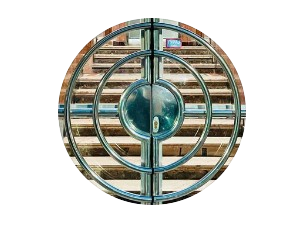Vračar
Guide to the most beautiful doorways of Belgrade
I invite you to take an exciting walking tour through the district called Vračar. The focus of our exploration will be the doors, behind which not only architectural masterpieces but also pieces of history are hidden. The duration of the route will be 1-2 hours, depending on the time you spend at each location. I tried to select the most impressive entrance groups for the route that will surely not leave you indifferent. On the route you can use a map with all the locations marked.

The name Vračar comes from the Serbian word "vrač", meaning "healer" or "shaman". This area is first mentioned in historical documents in the year 1440.
In the second half of the 19th century, the lower part of Vračar was still marshy. The beginning of the development of modern Vračar is associated with the Scot Francis Mackenzie and the Society for the Improvement of Vračar.
Francis Mackenzie was an employee of the English embassy. He bought land in the area of today's Slavija Square, Chubura, and Kruska Street, drained it, divided it into plots, and sold it. He kept a plot for himself, on which he built his house.
Although Mackenzie was the first resident of the hill on the outskirts of the city, the Society, through its painstaking work, managed to make Vračar what we know it as today. Vračar gained the status of an elite part of the city thanks to the members of the Society who chose this part of the city to build their homes.
In the second half of the 19th century, the lower part of Vračar was still marshy. The beginning of the development of modern Vračar is associated with the Scot Francis Mackenzie and the Society for the Improvement of Vračar.
Francis Mackenzie was an employee of the English embassy. He bought land in the area of today's Slavija Square, Chubura, and Kruska Street, drained it, divided it into plots, and sold it. He kept a plot for himself, on which he built his house.
Although Mackenzie was the first resident of the hill on the outskirts of the city, the Society, through its painstaking work, managed to make Vračar what we know it as today. Vračar gained the status of an elite part of the city thanks to the members of the Society who chose this part of the city to build their homes.
Kneza Miloša 19



At the turn of the century, the first generation of Serbian architects, who received their education domestically, began their practice, building a young country that was trying to distance itself from the East and turn towards the West. Nikola Nestorović was one of the most influential architects of the first decades of the 20th century and a professor who passed on his love for construction and Belgrade to his students. In the years leading up to the First World War, significant buildings such as the National Museum, the Belgrade Cooperative, the Bristol Hotel, the Teacher's House, a passage and Nikola Spasić's building, and one of the most impressive Art Nouveau-style buildings—the "House with the Green Tiles" on Kralja Petra—were constructed according to his designs.
Nestorović designed a house for the Petronijević family on Kneza Miloša Street, completed in 1924. As was common in most buildings in Belgrade at that time, shops were located on the ground floor, with apartments on the upper floors.
The acquaintance between Petronijević and Nestorović occurred through their joint participation in the Bošković bank, where Miloš Petronijević was the chairman of the supervisory board, and Nestorović was one of the shareholders and a member of the board of directors.
The Petronijević family home inherited the memory of three very important Serbian families who participated in the creation and shaping of modern Serbian statehood — the Petronijević family, the Piroćanac family, and the Jurišić-Šturm family. Miloš Petronijević's father, Milan, was one of Serbia's most important diplomats in the second half of the 19th century, as well as the Minister of Foreign Affairs. Milan Piroćanac served as Prime Minister of Serbia and also held the position of Minister of Justice. General Jurišić-Šturm is among the greatest military leaders of the First World War and Serbian military history.
This building houses the memorial collection and research center "Petronijević House," founded in the summer of 2017 as an association of citizens aimed at studying the processes of modernization and modernity in Serbia. The property it preserves is associated with the formation and definition of modernization primarily in politics but also in the culture and daily life of Serbia and Belgrade in the 19th and 20th centuries.
Nestorović designed a house for the Petronijević family on Kneza Miloša Street, completed in 1924. As was common in most buildings in Belgrade at that time, shops were located on the ground floor, with apartments on the upper floors.
The acquaintance between Petronijević and Nestorović occurred through their joint participation in the Bošković bank, where Miloš Petronijević was the chairman of the supervisory board, and Nestorović was one of the shareholders and a member of the board of directors.
The Petronijević family home inherited the memory of three very important Serbian families who participated in the creation and shaping of modern Serbian statehood — the Petronijević family, the Piroćanac family, and the Jurišić-Šturm family. Miloš Petronijević's father, Milan, was one of Serbia's most important diplomats in the second half of the 19th century, as well as the Minister of Foreign Affairs. Milan Piroćanac served as Prime Minister of Serbia and also held the position of Minister of Justice. General Jurišić-Šturm is among the greatest military leaders of the First World War and Serbian military history.
This building houses the memorial collection and research center "Petronijević House," founded in the summer of 2017 as an association of citizens aimed at studying the processes of modernization and modernity in Serbia. The property it preserves is associated with the formation and definition of modernization primarily in politics but also in the culture and daily life of Serbia and Belgrade in the 19th and 20th centuries.
Krunska 22



Krunska Street got its name from the Serbian word kruna meaning "crown," but it changed its name a total of 12 times. In 1946–1951, it even briefly became Moskovska (Moscow Street).
The residential building at 22 Krunska Street was built in 1936 according to the design of the architect Andrei Papkov for the industrialist Milutin Mesarovich, industrialist and author of works on economics. Andrei Vasilievich Papkov, a Russian emigrant who arrived in the capital of the Kingdom of Yugoslavia after the October Revolution, was one of many Russian architects who received their basic knowledge necessary for their future vocation in Belgrade. In 1925 he graduated from the architectural department of the technical faculty at the University of Belgrade.
The design of the building on Krunska lacks the elements of modernism that Papkov so often combined with historical styles. On the facade you will find one of the most interesting coats of arms that Papkov ever made - this is the figure of a boy holding a coat of arms on his left shoulder, framed by a wreath, in the center of which is the letter M - the initials of the owner of the building. The same initials can be seen in the forged elements of the front door.
The residential building at 22 Krunska Street was built in 1936 according to the design of the architect Andrei Papkov for the industrialist Milutin Mesarovich, industrialist and author of works on economics. Andrei Vasilievich Papkov, a Russian emigrant who arrived in the capital of the Kingdom of Yugoslavia after the October Revolution, was one of many Russian architects who received their basic knowledge necessary for their future vocation in Belgrade. In 1925 he graduated from the architectural department of the technical faculty at the University of Belgrade.
The design of the building on Krunska lacks the elements of modernism that Papkov so often combined with historical styles. On the facade you will find one of the most interesting coats of arms that Papkov ever made - this is the figure of a boy holding a coat of arms on his left shoulder, framed by a wreath, in the center of which is the letter M - the initials of the owner of the building. The same initials can be seen in the forged elements of the front door.
Kralja Milutina 15



Kralja Milutina Street was named after the Serbian King Stefan Uros II Milutin Nemanjic, the youngest son of Uros I and Helen of Anjou. Through skillful diplomacy and excellent military skills, he strengthened Serbia and expanded it. He reigned for more than 40 years and built the same number of churches during this time.
The house at number 15 was built for Milivoj Joksimovic according to the design of the architect Milorad Milutinovic in 1932. Milivoje Joksimovic was a respected artillery and technical general. He graduated from the military academy in Belgrade and, as the best in his class, was sent to Russia for further training. After finishing his studies in Petrograd, as the best in his class, he received a gold watch from the Russian Emperor Nicholas.
The house at number 15 was built for Milivoj Joksimovic according to the design of the architect Milorad Milutinovic in 1932. Milivoje Joksimovic was a respected artillery and technical general. He graduated from the military academy in Belgrade and, as the best in his class, was sent to Russia for further training. After finishing his studies in Petrograd, as the best in his class, he received a gold watch from the Russian Emperor Nicholas.
Krunska 50



At the end of 1900, by the Decree on Categorization, Krunska Street was designated as a street for the construction of mansions, but it acquired a residential status only after the First World War - when prestigious buildings were built. Villa number 50 most closely reflects the raise of the Balkan Kingdom. This is an unusual building in its purpose, which can be defined as a “multi-apartment villa”. Although, judging by some details of the facade, it can also be classified as a palace. The building resembles the Atina palace located on Terazije - they are united not only by three arches to decorate the terrace, but also by their size.
The building was built by the architect Svetozar Jovanović, assisted by the sculptor Sreten Stojanović. An outstanding Serbian architect and one of the founders of academicism in Serbia, Jovanović, was a professor at the Faculty of Engineering and served in the Ministry of Construction. His most famous works are, of course, the Officers' Cooperative Building and the Ministry of Transport Building.
In accordance with the design specifications, a residential villa with 14 apartments on Krunska was supposed to attract the wealthy segments of society with what they liked. And these are sculptures of cupids picking grapes and playing the flute, antique medallion applications on the facade, Mediterranean vases on the terrace railing and, of course, stone lion heads. A fence made of thick wrought iron and the same gate serve the same purpose. The interior is made of stucco marble and geometric mosaics. The apartments have double doors, white with green wooden inserts. This rare combination was used because the new class was looking for a new aesthetic.
The great Serbian actress Ruzica Sokic spent most of her life in the house on Krunska 50. Now the house houses the Foundation named after her.
The building was built by the architect Svetozar Jovanović, assisted by the sculptor Sreten Stojanović. An outstanding Serbian architect and one of the founders of academicism in Serbia, Jovanović, was a professor at the Faculty of Engineering and served in the Ministry of Construction. His most famous works are, of course, the Officers' Cooperative Building and the Ministry of Transport Building.
In accordance with the design specifications, a residential villa with 14 apartments on Krunska was supposed to attract the wealthy segments of society with what they liked. And these are sculptures of cupids picking grapes and playing the flute, antique medallion applications on the facade, Mediterranean vases on the terrace railing and, of course, stone lion heads. A fence made of thick wrought iron and the same gate serve the same purpose. The interior is made of stucco marble and geometric mosaics. The apartments have double doors, white with green wooden inserts. This rare combination was used because the new class was looking for a new aesthetic.
The great Serbian actress Ruzica Sokic spent most of her life in the house on Krunska 50. Now the house houses the Foundation named after her.
Prote Mateje 52



At the turn of the 19th and 20th centuries, new trends emerged in the understanding and development of architectural styles. The architecture of Serbia during this period contains influences from several styles that were dominant in Central Europe at the time. The greatest influence was exerted by the styles of the Vienna Secession, Munich Art Nouveau and French Art Nouveau. Art Nouveau came to Serbia through Serbian architects that studied abroad, while French decorative architecture became present immediately after the Paris Exhibition held in 1900.
The building at 52 Prote Matee was built in 1912 in the spirit of academicism, with neo-baroque elements, as well as modern plastic elements on the facade. The main fasade of the building is divided into a ground floor and an upper floor zone by a cornice. The building is decorated with luxurious floral motifs and the entrance gate has a special stylistic and craft value.
Despite the fact that the building is not recognized as an architectural monument, it is an important object in the structure of Old Belgrade, since it represents its oldest part, built during the period when the city was transformed into a modern European city and significantly expanded its territory by laying out new streets, including in the Western Vrachar area.
The building at 52 Prote Matee was built in 1912 in the spirit of academicism, with neo-baroque elements, as well as modern plastic elements on the facade. The main fasade of the building is divided into a ground floor and an upper floor zone by a cornice. The building is decorated with luxurious floral motifs and the entrance gate has a special stylistic and craft value.
Despite the fact that the building is not recognized as an architectural monument, it is an important object in the structure of Old Belgrade, since it represents its oldest part, built during the period when the city was transformed into a modern European city and significantly expanded its territory by laying out new streets, including in the Western Vrachar area.
Novopazarska 51



The building was built in 1927, but its author still remains unknown, since the project was not preserved in the Historical Archives of Belgrade. According to some reports, the architect was Dusan Dingarat. The owner of the building would presumably be artillery general Milorad Lazareviě, who participated in the First World War.
During the initial decades of the 20th century, architects started focusing on entrance groups with particular attention. Entrance portals gained prominence, particularly in instances where buildings were positioned several meters back from street regulations, often featuring a garden upfront. This scenario applies to the mentioned residential building. Positioned above the entrance, the balcony acts as a canopy, further accentuating the grandeur of the classic double-leaf portal with a lunette. Adorning the entrance are a pair of sphinxes crafted from artificial stone, a rarity in residential architecture of the period, undoubtedly signaling the presence of a wealthy investor.
During the initial decades of the 20th century, architects started focusing on entrance groups with particular attention. Entrance portals gained prominence, particularly in instances where buildings were positioned several meters back from street regulations, often featuring a garden upfront. This scenario applies to the mentioned residential building. Positioned above the entrance, the balcony acts as a canopy, further accentuating the grandeur of the classic double-leaf portal with a lunette. Adorning the entrance are a pair of sphinxes crafted from artificial stone, a rarity in residential architecture of the period, undoubtedly signaling the presence of a wealthy investor.
Maksima Gorkog 35



The building of entrepreneur Sreten Stojanović was constructed in 1930. The project was authored by architect Žura Borošić, who at that time was an assistant at the Department of Architecture of the Technical Faculty of the University of Belgrade. In the mid-1920s, he founded one of the first modern architectural bureaus. It survived until the Second World War, and many outstanding architects, such as Jovan Belović and Momčilo Belobrk, passed through it. Borošić's legacy mainly consists of residential buildings, with the most successful achievements in public buildings being the "Prag" Hotel and the "Zlatibor" Bank on Čika Ljubina Street.
The building on Maksima Gorkog Street was built shortly after the construction of the "Prag" Hotel, which is one of the architect's most significant accomplishments. Between these two buildings, there are clear analogies; the building on Maksima Gorkog Street can be perceived as a more modest version of the representative and monumental solution of the "Prag" Hotel. Despite its modest size, the building on Maksima Gorkog Street was realized as a representative structure. One particular feature of this building, placing it among the representative achievements of Art Deco, is the artistic treatment of the facade surfaces using figurative relief decorations, created by sculptor Dragomir Arambašić. This sculptor is also credited with the fountain "Awakening," located in front of the central entrance to the Art Pavilion "Cvijeta Zuzorić" in Kalemegdan, and the sculptures symbolizing industry and trade on the building of the Nikola Spasić Foundation at Kneza Mihaila Street 47.
The building on Maksima Gorkog Street was built shortly after the construction of the "Prag" Hotel, which is one of the architect's most significant accomplishments. Between these two buildings, there are clear analogies; the building on Maksima Gorkog Street can be perceived as a more modest version of the representative and monumental solution of the "Prag" Hotel. Despite its modest size, the building on Maksima Gorkog Street was realized as a representative structure. One particular feature of this building, placing it among the representative achievements of Art Deco, is the artistic treatment of the facade surfaces using figurative relief decorations, created by sculptor Dragomir Arambašić. This sculptor is also credited with the fountain "Awakening," located in front of the central entrance to the Art Pavilion "Cvijeta Zuzorić" in Kalemegdan, and the sculptures symbolizing industry and trade on the building of the Nikola Spasić Foundation at Kneza Mihaila Street 47.
Svetog Save 36



The building was constructed in 1933 according to the design by Leon Talvi for Nikodija and Marika Bogdanović. Nikodija Bogdanović achieved success both in military service and as a businessman. He received all Serbian bravery awards for his military merits and led a very active public life, serving as the president of the Association of Reserve Officers and Soldiers. In Belgrade, together with engineer Krsto Anđus, he founded the company "Bogdanović-Anđus," which operated until the Second World War. He also owned a packaging enterprise and served as the director of an aircraft engine factory in Zemun.
The building on Svetog Save street holds special significance as Leon Talvi's most outstanding architectural achievement, a representative work of interwar academicism, and an important testament to the architectural and urban development of Belgrade. Its eclectic architecture with neo-Baroque elements possesses a distinctive and specific style that doesn't fully adhere to academic norms. Talvi incorporated Baroque elements such as cordoned cornices, pilasters, and lunettes above the windows, as well as a prominently featured portal on Svetog Save street, reminiscent of Gaudi's bold concepts.
The building on Svetog Save street holds special significance as Leon Talvi's most outstanding architectural achievement, a representative work of interwar academicism, and an important testament to the architectural and urban development of Belgrade. Its eclectic architecture with neo-Baroque elements possesses a distinctive and specific style that doesn't fully adhere to academic norms. Talvi incorporated Baroque elements such as cordoned cornices, pilasters, and lunettes above the windows, as well as a prominently featured portal on Svetog Save street, reminiscent of Gaudi's bold concepts.
Svetog Save 32



Andže Petrović's residential building was designed by engineer Branko Đurić in March 1933, but in November of the same year, architect Momčilo Belobrk was hired to rework the original design. This project represents the only example of Belobrk's deviation from modernism, possibly due to the reworking of an already completed project.
Belobrk, first in the bureau of Žura Borošić, and then independently, designed and built an impressive series of approximately sixty residential buildings, among which the houses on Svetogorska Street, as well as on the corners of Dositeeva and Dobrachina streets, hold a special place.
The name of Momčilo Belobrk, one of the most famous names in interwar architecture, is almost exclusively associated with residential buildings, although monumental ones marked the beginning and end of his career in construction. It was his projects from his student days, such as the House of Music and the Catholic Archbishop's Church, that prompted the renowned art historian of the interwar period, Dragan Aleksić, to call Belobrk "the only absolute and free talent" among young Serbian architects. And one monumental work, created towards the end of his career — the reconstruction of the Yugoslav Drama Theater — elevated Belobrk to the position of someone who practically allowed for a break from the prevailing theory and practice of "socialist realism" at the time.
Belobrk, first in the bureau of Žura Borošić, and then independently, designed and built an impressive series of approximately sixty residential buildings, among which the houses on Svetogorska Street, as well as on the corners of Dositeeva and Dobrachina streets, hold a special place.
The name of Momčilo Belobrk, one of the most famous names in interwar architecture, is almost exclusively associated with residential buildings, although monumental ones marked the beginning and end of his career in construction. It was his projects from his student days, such as the House of Music and the Catholic Archbishop's Church, that prompted the renowned art historian of the interwar period, Dragan Aleksić, to call Belobrk "the only absolute and free talent" among young Serbian architects. And one monumental work, created towards the end of his career — the reconstruction of the Yugoslav Drama Theater — elevated Belobrk to the position of someone who practically allowed for a break from the prevailing theory and practice of "socialist realism" at the time.
Free online guides
to the most beautiful doorways of Belgrade
For more beautiful door locations follow us on Instagram.
Join us on a daily door exploration – we share one post every day.
You can also find much more locations for you walks on our Google Map.
Join us on a daily door exploration – we share one post every day.
You can also find much more locations for you walks on our Google Map.
All rights reserved.
Any copying and reproduction of text, photos and/or graphic materials, including partial and in any forms,
Any copying and reproduction of text, photos and/or graphic materials, including partial and in any forms,
without the written permission of the copyright holder is prohibited.





